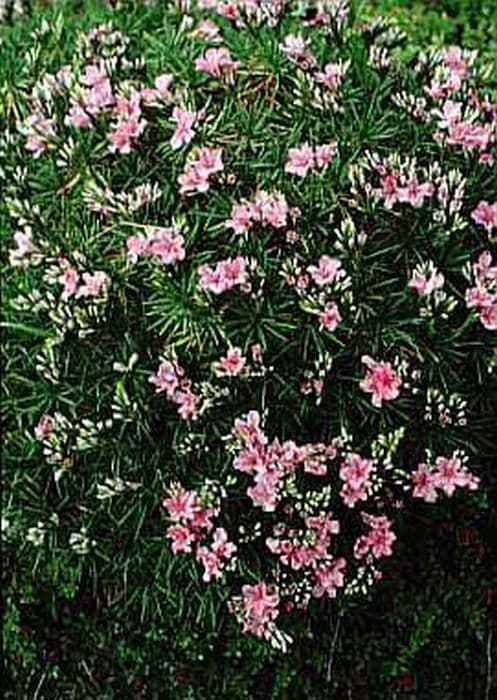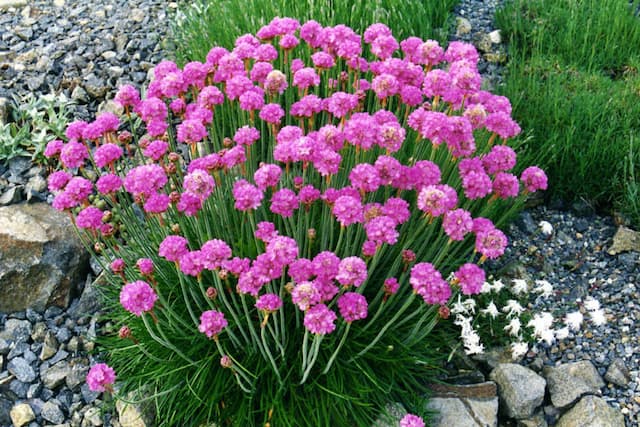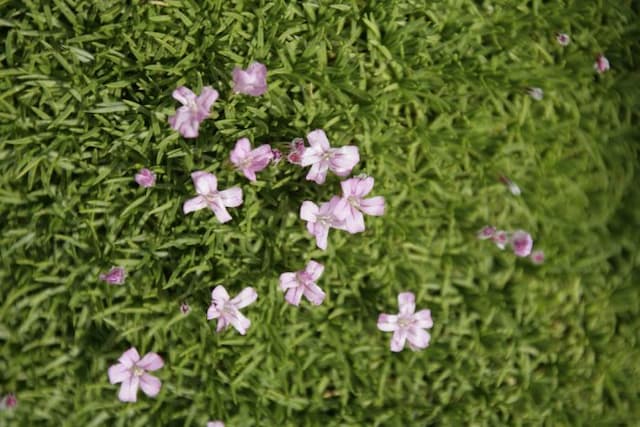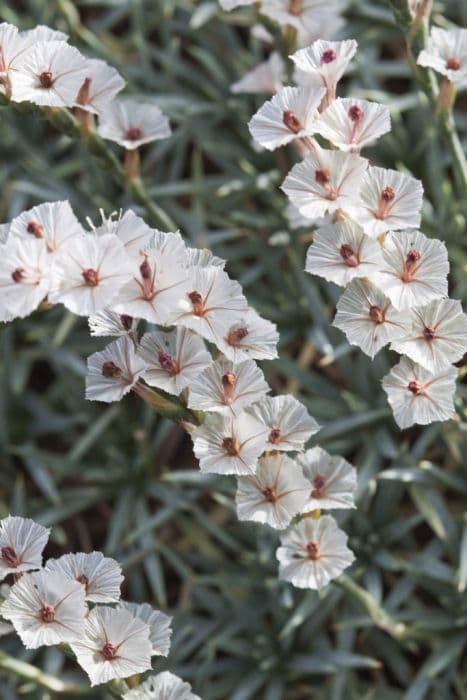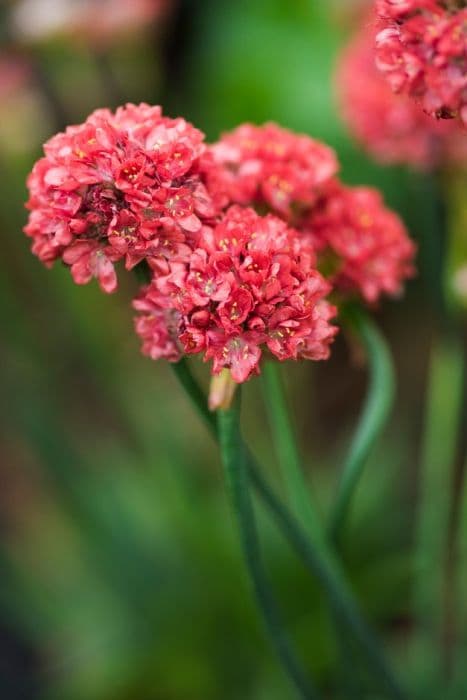Thrift Armeria maritima

ABOUT
Armeria maritima, commonly known as sea thrift or sea pink, is a compact, evergreen perennial plant that forms dense, mounded tufts. Its appearance is characterized by a foliage of needle-like leaves, which are dark green in color and create a cushion-like structure. Throughout the blooming season, sea thrift produces globular flower heads that rise above the foliage on slender, erect stalks. The flowers themselves are small, numerous, and tightly packed together, creating a pom-pom effect. These blooms exhibit shades of pink, and less commonly, white or red, lending a vibrant and delicate touch to the plant's overall appearance. The blossoms are favored by gardeners for their ability to add a splash of color to rock gardens, borders, and coastal landscapes. Sea thrift's foliage and flowers together contribute to its neat and tidy look, often described as grassy or tufted, making it a popular choice for gardens aiming for a natural yet structured aesthetic.
About this plant
 Names
NamesFamily
Plumbaginaceae
Synonyms
Sea Thrift, Sea Pink, Marsh Daisy, Sea Grass, Sea Gilles
Common names
Armeria elongata, Armeria vulgaris, Statice armeria, Statice maritima.
 Toxicity
ToxicityTo humans
Armeria maritima, commonly known as sea thrift, is not widely recognized as a toxic plant to humans. However, as with many plants, individual sensitivities and allergic reactions are possible. In general, it is not considered edible, and ingestion is typically discouraged due to the potential for gastrointestinal discomfort or more serious health issues if consumed in large quantities. If you suspect poisoning from sea thrift, you should seek medical attention immediately.
To pets
Sea thrift, the common name for Armeria maritima, is not commonly known to be toxic to pets. However, similar to humans, pets may have individual sensitivities leading to allergic reactions or gastrointestinal upset. While no specific symptoms of poisoning from sea thrift in pets are widely documented, it is always best to prevent pets from ingesting plants not meant for consumption. If your pet shows signs of distress after ingesting this plant, consult your veterinarian.
 Characteristics
CharacteristicsLife cycle
Perennials
Foliage type
Evergreen
Color of leaves
Green
Flower color
Pink
Height
0.5 feet (15 cm)
Spread
1 feet (30 cm)
Plant type
Herb
Hardiness zones
4
Native area
Europe
Benefits
 General Benefits
General Benefits- Drought tolerance: Armeria maritima is highly resistant to drought, making it ideal for xeriscaping and water-efficient gardens.
- Low maintenance: It requires minimal care once established, reducing the need for constant gardening intervention.
- Salt tolerance: As a seaside plant, it can thrive in coastal conditions and tolerate salt spray, useful for beachfront landscaping.
- Erosion control: The plant’s dense growth habit helps to stabilize soils and prevent erosion, especially in sloped areas.
- Attracts pollinators: It provides nectar for bees and butterflies, promoting biodiversity in the garden.
- Aesthetic appeal: With its grassy foliage and pink to lavender flowers, it adds visual interest to rock gardens, borders, and ornamental beds.
- Durability: Armeria maritima has a tough constitution, surviving in challenging environments where other plants might fail.
- Compact growth: Its small, mounding form makes it suitable for tight spaces and container gardening.
- Long blooming season: It has a lengthy flowering period from late spring to early summer, with potential reblooms in fall.
 Medical Properties
Medical Properties- Diuretic: Armeria maritima may have been used traditionally to promote the excretion of urine.
- Astringent: The plant could have past uses as an astringent to constrict tissues and reduce bleeding or secretions.
 Air-purifying Qualities
Air-purifying QualitiesThis plant is not specifically known for air purifying qualities.
 Other Uses
Other Uses- Ground Cover: Sea Thrift is used to stabilize soil as it develops a thick mat of roots that can help prevent soil erosion.
- Rock Gardens: With its ability to grow in rocky, coastal areas, Sea Thrift is often planted in rock gardens for its toughness and low-growing form.
- Seafront Landscape: Sea Thrift, due to its salt tolerance, is ideal for gardens near the ocean or in seaside towns.
- Edging Plants: Its compact size and round shape make Sea Thrift suitable for edges in garden pathways or flowerbeds.
- Ornamental Borders: Gardeners may use Sea Thrift to create colorful, low-maintenance borders around yards or garden features.
- Bee Attraction: The flowers of Sea Thrift attract bees, which make them a good option for pollinator-friendly gardens.
- Flower Arrangements: The globular clusters of flowers can be cut and used in fresh or dried floral arrangements due to their long-lasting qualities.
- Green Roof Planting: Because of its resistance to harsh conditions, Sea Thrift can be utilized in green roof installations.
- Turf Replacement: In areas where traditional turf grass struggles, Sea Thrift can serve as an attractive alternative ground cover.
- Xeriscaping: Suited for drought-prone areas, Sea Thrift can be included in xeriscapes to reduce the need for irrigation.
Interesting Facts
 Feng Shui
Feng ShuiArmeria maritima, commonly known as Thrift, is not used in Feng Shui practice.
 Zodiac Sign Compitability
Zodiac Sign CompitabilityThrift is not used in astrology practice.
 Plant Symbolism
Plant Symbolism- Resilience: Armeria maritima, commonly known as sea thrift, often grows in tough coastal environments, symbolizing the ability to endure and thrive in challenging conditions.
- Perseverance: Its ability to survive salty, windy habitats where few plants can live represents determination and the persistence to overcome adversity.
- Adaptability: Sea thrift's tolerance to various soil types and exposure to the elements signifies flexibility and the capacity to adjust to different circumstances.
- Conservation: As a plant that is part of coastal ecosystems, it signifies the importance of preserving natural habitats and biodiversity.
- Beauty and Simplicity: The delicate pink or white flowers of sea thrift bloom in simple yet beautiful clusters, representing the notion that there is beauty in simplicity and modesty.
 Water
WaterThe common name for Armeria maritima is sea thrift. When watering sea thrift, it's important to ensure that the soil is well-drained and not overly saturated. Generally, this plant requires moderate watering, avoiding waterlogging the roots. Water sea thrift thoroughly, allowing the soil to dry out between waterings, which could mean watering approximately every week or so, depending on the climate and weather conditions. Aim for about one gallon of water per plant, ensuring consistent moisture levels during the growing season.
 Light
LightSea thrift thrives best in full sunlight conditions. It's essential to plant sea thrift in a spot where it receives at least six hours of direct sunlight daily. These plants can tolerate partial shade but will produce the most robust growth and best flowering results when given ample sunlight.
 Temperature
TemperatureSea thrift is hardy and can tolerate a wide range of temperatures, but it performs best in cooler climates. It prefers temperatures ranging between 60°F and 75°F. Sea thrift can generally survive winter temperatures as low as 10°F but should be protected from severe freezes. The ideal growing conditions are cool to moderate temperatures without extreme heat or cold.
 Pruning
PruningSea thrift benefits from occasional pruning to remove spent flowers and encourage a tidy growth habit. After the main blooming period, typically in late spring or early summer, trim back the faded flower stems. This not only keeps the plant looking neat but can stimulate a second, although less profuse, flush of flowers. Pruning should be done yearly, after the main bloom cycle.
 Cleaning
CleaningAs needed
 Soil
SoilThrift (Armeria maritima) prefers well-draining, sandy soil with a slightly acidic to neutral pH between 5.5 and 7.5. A mix of two parts sand, one part peat, and one part loamy garden soil is ideal for optimal growth.
 Repotting
RepottingThrift (Armeria maritima) generally does not require frequent repotting and can be done every two to three years, or as needed when the plant outgrows its current container.
 Humidity & Misting
Humidity & MistingSea Thrift (Armeria maritima) tolerates a range of humidity levels but thrives in moderate conditions, aligning with average outdoor humidity. It is generally drought-tolerant once established.
 Suitable locations
Suitable locationsIndoor
Choose bright light, well-drained soil, and cool room for indoor Sea Thrift.
Outdoor
Plant Sea Thrift in full sun, well-drained soil, water sparingly.
Hardiness zone
3-9 USDA
 Life cycle
Life cycleSea Thrift (Armeria maritima) begins its life cycle as a seed, which upon finding suitable conditions germinates in early spring. The seedling develops into a compact, evergreen perennial with grass-like leaves, forming a dense tuft. As it matures, typically in late spring to early summer, Sea Thrift produces flowering stalks topped with globe-shaped pink, violet, or white flowers, which are pollinated by insects or through self-fertilization. After pollination, the flowers produce small capsules containing numerous seeds that are eventually dispersed by wind, water, or animal activity. The plant may also spread vegetatively through the growth of its underground rhizomes. In winter, the above-ground part of the plant may die back, but the plant remains dormant and will regrow from the perennial rootstock when conditions improve in spring.
 Propogation
PropogationPropogation time
Spring to early summer
Propogation: Thrift, also known as Armeria maritima, is commonly propagated through division, which is most successfully done in spring or early fall. This involves carefully lifting the parent plant from the ground with a garden fork or shovel and gently separating it into smaller clumps, ensuring each new section has a portion of the root system intact. These individual clumps can then be planted directly into the garden or into pots with well-draining soil, spaced about 6 to 12 inches (15 to 30 centimeters) apart to allow room for growth. Regular watering helps the new divisions to establish, but it's important to ensure the soil does not become waterlogged, which could harm the plant. Division is a reliable way to maintain the health of the clumps, preventing them from becoming too congested, which can lead to reduced flowering.


